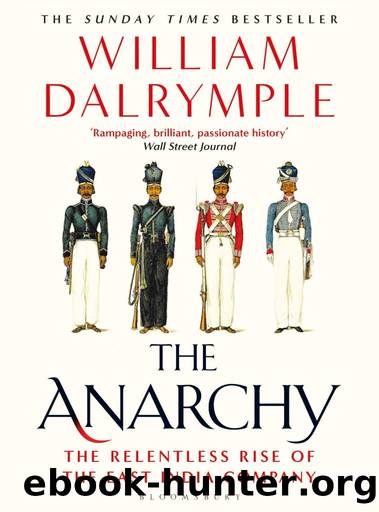The Anarchy: The Relentless Rise of the East India Company by William Dalrymple

Author:William Dalrymple [Dalrymple, William]
Language: eng
Format: azw3
Tags: Technology & Engineering, Colonialism & Post-Colonialism, Business, Asia, Nonfiction, Political Science, 18th Century, Biography & Autobiography, Military, History
ISBN: 9781408864401
Publisher: Bloomsbury Publishing
Published: 2019-09-09T23:00:00+00:00
Ten days later, on 25 August 1780, the Companyâs largest concentration of troops in southern India finally marched out of Madras and headed south along the coast road towards Kanchipuram to confront Haidar. At their head was Sir Hector Munro, the Highland general who fifteen years earlier had snatched victory from the jaws of defeat when he broke Shuja ud-Daulaâs lines at Buxar. This time, however, he had only managed to muster 5,000 sepoys â they were unpaid and semi-mutinous â and they were facing a force 100,000 strong.
Twenty-five miles to the north, another Scot, Colonel William Baillie, had just received instructions to rendezvous with Munro at Kanchipuram with a second force of 2,800, most of whom were local sepoys, accompanied by a few hundred newly arrived Highlanders. If these two small armies were able to join up, they would only be outnumbered ten to one, and might have some chance of taking on the Mysore troops; but divided as they were, neither force stood much chance of success against so well trained and disciplined a force as Haidar had assembled, an army that, according to Ghulam Hussain Khan, âcovered the plains like waves of an angry sea, and with a trail of artillery that had no endâ.112 Munro should have waited for Baillie to join him, but, as impatient as ever, and hearing that there were ample provisions and a full magazine in Kanchipuram, which Haidar might otherwise have seized for himself, Munro headed off with his small force, when a single dayâs delay would have allowed the two armies to unite.
On the evening of 25 August, Baillie camped on the banks of the small river Kortalaiyar, north-west of Madras. That evening, the monsoon broke and it rained heavily and without a break for twelve hours. By first light, the Kortalaiyar had become a raging torrent, impossible to ford. It was eleven days before Baillie was able to move his troops across it, and, by the time he did so, Tipu had managed to interpose 11,000 of his best cavalry between Baillie and Munro.113 He could now pick off Baillieâs vulnerable column at his leisure.
The first engagement took place on 6 September, when a long-range artillery duel took place between the two armies. Baillieâs small force âwandering about in thick, drizzling rain, knee-deep in rice fieldsâ was much more exposed and suffered heavy casualties, but neither army committed to close combat, and both called for reinforcements.114 Haidar sent a large force to his son, but Munro refused to move from the principal temple at Kanchipuram, which he had now fortified sufficiently to resist a siege.
His one concession was to send a column of a thousand sepoys, along with nine camels carrying ammunition, to join Baillieâs column and lead it back to the temple. The relief column moved swiftly at night, threw off the pursuing Mysore cavalry in the darkness and, making a wide detour to avoid running into Tipuâs main army, managed successfully to make a junction with Baillie, bringing the number of his troops up to 3,800 and ten field pieces.
Download
This site does not store any files on its server. We only index and link to content provided by other sites. Please contact the content providers to delete copyright contents if any and email us, we'll remove relevant links or contents immediately.
Kathy Andrews Collection by Kathy Andrews(10562)
The remains of the day by Kazuo Ishiguro(7582)
Spare by Prince Harry The Duke of Sussex(4228)
Paper Towns by Green John(4179)
The Body: A Guide for Occupants by Bill Bryson(3828)
Be in a Treehouse by Pete Nelson(3238)
Harry Potter and the Goblet Of Fire by J.K. Rowling(3098)
Goodbye Paradise(2985)
Never by Ken Follett(2915)
Into Thin Air by Jon Krakauer(2714)
The Remains of the Day by Kazuo Ishiguro(2629)
The Genius of Japanese Carpentry by Azby Brown(2619)
The Cellar by Natasha Preston(2607)
Drawing Shortcuts: Developing Quick Drawing Skills Using Today's Technology by Leggitt Jim(2537)
120 Days of Sodom by Marquis de Sade(2449)
Architecture 101 by Nicole Bridge(2358)
Machine Learning at Scale with H2O by Gregory Keys | David Whiting(2325)
The Man Who Died Twice by Richard Osman(2313)
Industrial Automation from Scratch: A hands-on guide to using sensors, actuators, PLCs, HMIs, and SCADA to automate industrial processes by Olushola Akande(2163)
